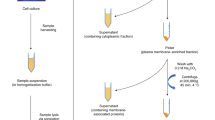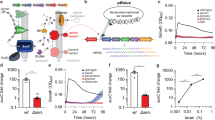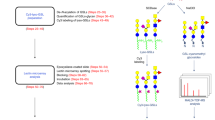Abstract
Protein O-glycosylation has key roles in many biological processes, but the repertoire of O-glycans synthesized by cells is difficult to determine. Here we describe an approach termed Cellular O-Glycome Reporter/Amplification (CORA), a sensitive method used to amplify and profile mucin-type O-glycans synthesized by living cells. Cells convert added peracetylated benzyl-α-N-acetylgalactosamine to a large variety of modified O-glycan derivatives that are secreted from cells, allowing for easy purification for analysis by HPLC and mass spectrometry (MS). Relative to conventional O-glycan analyses, CORA resulted in an ∼100–1,000-fold increase in sensitivity and identified a more complex repertoire of O-glycans in more than a dozen cell types from Homo sapiens and Mus musculus. Furthermore, when coupled with computational modeling, CORA can be used for predictions about the diversity of the human O-glycome and offers new opportunities to identify novel glycan biomarkers for human diseases.
This is a preview of subscription content, access via your institution
Access options
Subscribe to this journal
Receive 12 print issues and online access
$259.00 per year
only $21.58 per issue
Buy this article
- Purchase on Springer Link
- Instant access to full article PDF
Prices may be subject to local taxes which are calculated during checkout





Similar content being viewed by others
References
Ohtsubo, K. & Marth, J.D. Glycosylation in cellular mechanisms of health and disease. Cell 126, 855–867 (2006).
Cummings, R.D. & Pierce, J.M. The challenge and promise of glycomics. Chem. Biol. 21, 1–15 (2014).
Shriver, Z., Raguram, S. & Sasisekharan, R. Glycomics: a pathway to a class of new and improved therapeutics. Nat. Rev. Drug Discov. 3, 863–873 (2004).
Steentoft, C. et al. Precision mapping of the human O-GalNAc glycoproteome through SimpleCell technology. EMBO J. 32, 1478–1488 (2013).
Tian, E. & Ten Hagen, K.G. Recent insights into the biological roles of mucin-type O-glycosylation. Glycoconj. J. 26, 325–334 (2009).
Ju, T. et al. Tn and sialyl-Tn antigens, aberrant O-glycomics as human disease markers. Proteomics Clin. Appl. 7, 618–631 (2013).
Ju, T., Aryal, R.P., Kudelka, M.R., Wang, Y. & Cummings, R.D. The Cosmc connection to the Tn antigen in cancer. Cancer Biomark. 14, 63–81 (2014).
Kudelka, M.R., Ju, T., Heimburg-Molinaro, J. & Cummings, R.D. Simple sugars to complex disease—mucin-type O-glycans in cancer. Adv. Cancer Res. 126, 53–135 (2015).
Furukawa, J., Fujitani, N. & Shinohara, Y. Recent advances in cellular glycomic analyses. Biomolecules 3, 198–225 (2013).
Ju, T. et al. A novel fluorescent assay for T-synthase activity. Glycobiology 21, 352–362 (2011).
Brockhausen, I. et al. Control of O-glycan synthesis: specificity and inhibition of O-glycan core 1 UDP-galactose:N-acetylgalactosamine-alpha-R beta 3-galactosyltransferase from rat liver. Biochem. Cell Biol. 70, 99–108 (1992).
Vavasseur, F., Yang, J.M., Dole, K., Paulsen, H. & Brockhausen, I. Synthesis of O-glycan core 3: characterization of UDP-GlcNAc: GalNAc-R beta 3-N-acetyl-glucosaminyltransferase activity from colonic mucosal tissues and lack of the activity in human cancer cell lines. Glycobiology 5, 351–357 (1995).
Okayama, M., Kimata, K. & Suzuki, S. The influence of p-nitrophenyl beta-d-xyloside on the synthesis of proteochondroitin sulfate by slices of embryonic chick cartilage. J. Biochem. 74, 1069–1073 (1973).
Sarkar, A.K., Fritz, T.A., Taylor, W.H. & Esko, J.D. Disaccharide uptake and priming in animal cells: inhibition of sialyl Lewis X by acetylated Gal beta 1→4GlcNAc beta-O-naphthalenemethanol. Proc. Natl. Acad. Sci. USA 92, 3323–3327 (1995).
Fuster, M.M., Brown, J.R., Wang, L. & Esko, J.D. A disaccharide precursor of sialyl Lewis X inhibits metastatic potential of tumor cells. Cancer Res. 63, 2775–2781 (2003).
Wilson, J.R. & Zimmerman, E.F. Yolk sac: site of developmental microheterogeneity of mouse alpha-fetoprotein. Dev. Biol. 54, 187–199 (1976).
Ju, T. & Cummings, R.D. A unique molecular chaperone Cosmc required for activity of the mammalian core 1 beta 3-galactosyltransferase. Proc. Natl. Acad. Sci. USA 99, 16613–16618 (2002).
Wilkins, P.P., McEver, R.P. & Cummings, R.D. Structures of the O-glycans on P-selectin glycoprotein ligand-1 from HL-60 cells. J. Biol. Chem. 271, 18732–18742 (1996).
Kawar, Z.S., Johnson, T.K., Natunen, S., Lowe, J.B. & Cummings, R.D. PSGL-1 from the murine leukocytic cell line WEHI-3 is enriched for core 2-based O-glycans with sialyl Lewis x antigen. Glycobiology 18, 441–446 (2008).
Morelle, W. & Michalski, J.C. Analysis of protein glycosylation by mass spectrometry. Nat. Protoc. 2, 1585–1602 (2007).
Hsu, P.P. & Sabatini, D.M. Cancer cell metabolism: Warburg and beyond. Cell 134, 703–707 (2008).
Wang, Y. et al. Platelet biogenesis and functions require correct protein O-glycosylation. Proc. Natl. Acad. Sci. USA 109, 16143–16148 (2012).
Dube, D.H. & Bertozzi, C.R. Glycans in cancer and inflammation—potential for therapeutics and diagnostics. Nat. Rev. Drug Discov. 4, 477–488 (2005).
Babu, P. et al. Structural characterisation of neutrophil glycans by ultra sensitive mass spectrometric glycomics methodology. Glycoconj. J. 26, 975–986 (2009).
Macher, B.A., Buehler, J., Scudder, P., Knapp, W. & Feizi, T. A novel carbohydrate, differentiation antigen on fucogangliosides of human myeloid cells recognized by monoclonal antibody VIM-2. J. Biol. Chem. 263, 10186–10191 (1988).
Sato, C. et al. Frequent occurrence of pre-existing alpha 2→8-linked disialic and oligosialic acids with chain lengths up to 7 Sia residues in mammalian brain glycoproteins. Prevalence revealed by highly sensitive chemical methods and anti-di-, oligo-, and poly-Sia antibodies specific for defined chain lengths. J. Biol. Chem. 275, 15422–15431 (2000).
Karlsson, N.G. & Thomsson, K.A. Salivary MUC7 is a major carrier of blood group I type O-linked oligosaccharides serving as the scaffold for sialyl Lewis x. Glycobiology 19, 288–300 (2009).
Delannoy, P. et al. Benzyl-N-acetyl-alpha-D-galactosaminide inhibits the sialylation and the secretion of mucins by a mucin secreting HT-29 cell subpopulation. Glycoconj. J. 13, 717–726 (1996).
Zanetta, J.P. et al. Massive in vitro synthesis of tagged oligosaccharides in 1-benzyl-2-acetamido-2-deoxy-alpha-D-galactopyranoside treated HT-29 cells. Glycobiology 10, 565–575 (2000).
Liu, J., Jin, C., Cherian, R.M., Karlsson, N.G. & Holgersson, J. O-glycan repertoires on a mucin-type reporter protein expressed in CHO cell pools transiently transfected with O-glycan core enzyme cDNAs. J. Biotechnol. 199, 77–89 (2015).
Cummings, R.D. The repertoire of glycan determinants in the human glycome. Mol. Biosyst. 5, 1087–1104 (2009).
Sato, T. et al. Single Lgr5 stem cells build crypt-villus structures in vitro without a mesenchymal niche. Nature 459, 262–265 (2009).
Gao, D. et al. Organoid cultures derived from patients with advanced prostate cancer. Cell 159, 176–187 (2014).
Park, I.H. et al. Disease-specific induced pluripotent stem cells. Cell 134, 877–886 (2008).
Dimos, J.T. et al. Induced pluripotent stem cells generated from patients with ALS can be differentiated into motor neurons. Science 321, 1218–1221 (2008).
Ju, T. et al. Human tumor antigens Tn and sialyl Tn arise from mutations in Cosmc. Cancer Res. 68, 1636–1646 (2008).
Jang-Lee, J. et al. Glycomic profiling of cells and tissues by mass spectrometry: fingerprinting and sequencing methodologies. Methods Enzymol. 415, 59–86 (2006).
Dong, Q.G. et al. A general strategy for isolation of endothelial cells from murine tissues. Characterization of two endothelial cell lines from the murine lung and subcutaneous sponge implants. Arterioscler. Thromb. Vasc. Biol. 17, 1599–1604 (1997).
Hartwell, D.W. et al. Role of P-selectin cytoplasmic domain in granular targeting in vivo and in early inflammatory responses. J. Cell Biol. 143, 1129–1141 (1998).
Acknowledgements
We thank J. Heimburg-Molinaro for help in editing and D.F. Smith and J. Zeng for critical reading of the manuscript. LOX cells were a kind gift from O. Fodstad (Oslo University Hospital, Oslo, Norway). MKN45, Colo205, MDA-MB-231 and MCF7 cells were a kind gift from H. Clausen (University of Copenhagen, Copenhagen, Denmark). pPSVE1-B1a was from J.D. Esko, UCSD, La Jolla, California, USA. BaGs6 anti-Tn was a kind gift from the late G. Springer (The Chicago Medical School, Chicago, Illinois, USA). This work was supported by the US National Institutes of Health (grants U01CA168930 to T.J. and R.D.C. and P41GM103694 to R.D.C.), a Georgia Cancer Coalition (now Georgia Research Alliance (GRA)) Award (to T.J.) and the Biotechnology and Biological Sciences Research Council (grant BB/K016164/1 to A.D. and S.M.H. for Core Support for Collaborative Research). A.D. is supported by a Wellcome Trust Senior Investigator Award. We also acknowledge support from the Emory Integrated Proteomics Core.
Author information
Authors and Affiliations
Contributions
M.R.K., R.D.C. and T.J. conceived of the project. M.R.K., Y.W., N.T.S., A.D., S.M.H., R.D.C. and T.J. designed experiments. M.R.K., A.A., Y.W., D.M.D. and X.S. performed experiments. M.R.K., A.A., Y.W., A.D., S.M.H., R.D.C. and T.J. analyzed the data. M.R.K., R.D.C. and T.J. wrote the manuscript. All authors edited the manuscript.
Corresponding author
Ethics declarations
Competing interests
The authors declare no competing financial interests.
Supplementary information
Supplementary Text and Figures
Supplementary Figures 1–24 and Supplementary Tables 1–3 (PDF 20370 kb)
Rights and permissions
About this article
Cite this article
Kudelka, M., Antonopoulos, A., Wang, Y. et al. Cellular O-Glycome Reporter/Amplification to explore O-glycans of living cells. Nat Methods 13, 81–86 (2016). https://doi.org/10.1038/nmeth.3675
Received:
Accepted:
Published:
Issue Date:
DOI: https://doi.org/10.1038/nmeth.3675
This article is cited by
-
Immunoengineering can overcome the glycocalyx armour of cancer cells
Nature Materials (2024)
-
Side population cells derived from hUCMSCs and hPMSCs could inhibit the malignant behaviors of Tn+ colorectal cancer cells from modifying their O-glycosylation status
Stem Cell Research & Therapy (2023)
-
Glycoengineered keratinocyte library reveals essential functions of specific glycans for all stages of HSV-1 infection
Nature Communications (2023)
-
Chemoenzymatic modular assembly of O-GalNAc glycans for functional glycomics
Nature Communications (2021)
-
Glycoproteomics identifies HOMER3 as a potentially targetable biomarker triggered by hypoxia and glucose deprivation in bladder cancer
Journal of Experimental & Clinical Cancer Research (2021)



